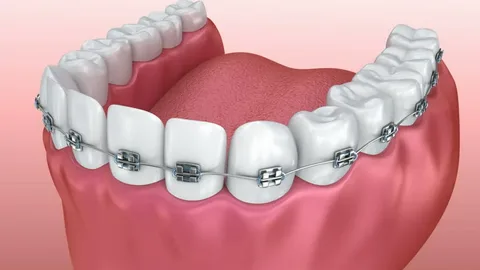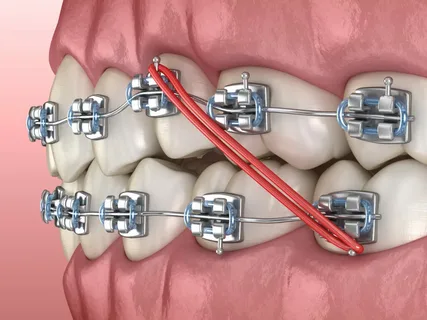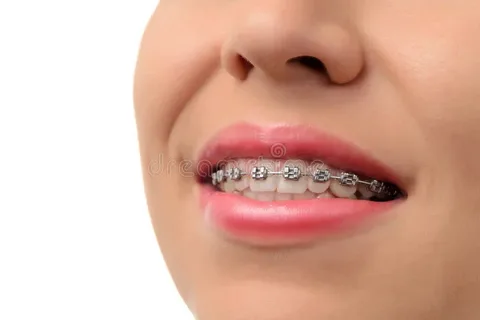Metal Braces
Metal braces have been the gold standard in orthodontic treatment for decades, effectively correcting misaligned teeth and bite issues. Though newer options like clear aligners have gained popularity, metal braces remain a reliable and cost-effective choice for people of all ages. This guide explores what metal braces are, how they work, their benefits, and other essential details to help you make an informed decision.
How Do Metal Braces Work?
The process of using metal braces involves the following steps:
Initial Consultation:
The orthodontist evaluates your teeth, bite, and overall oral health through physical exams, X-rays, and impressions.
Placement of Braces:
Brackets are bonded to the teeth using a dental adhesive.
A metal archwire is threaded through the brackets and secured with elastic bands or clips. This wire is what applies the pressure to move the teeth.
Adjustments:
Every 4–6 weeks, the orthodontist adjusts the wires and sometimes replaces the elastic bands to maintain steady pressure on the teeth.
Completion of Treatment:
Once the teeth have moved into their correct positions, the braces are removed. Retainers are then provided to maintain the results.
What Orthodontic Issues Can Metal Braces Address?
Metal braces are highly effective for correcting a wide range of orthodontic problems, including:
Severe overcrowding
Large gaps between teeth
Overbite, underbite, and crossbite
Misaligned or rotated teeth
Jaw alignment issues
They are often recommended for complex cases that cannot be treated with other orthodontic options like aligners.
Benefits of Metal Braces
Effectiveness:
Metal braces are one of the most effective orthodontic treatments available, capable of addressing even severe misalignments and bite issues.
Cost-Effective:
Compared to clear aligners or ceramic braces, metal braces are generally more affordable, making them accessible to a wider range of patients.
Durability:
Made from stainless steel, metal braces are strong and durable, withstanding the forces required to move teeth.
Versatility:
Metal braces can treat a wide range of orthodontic issues, from simple alignment problems to complex cases involving significant bite correction.
Customizable Appearance:
Elastic bands come in various colors, allowing patients (especially children) to personalize their braces.
Limitations of Metal Braces
Appearance:
Metal braces are highly visible, which can be a concern for some people who prefer a more discreet option.
Discomfort:
Brackets and wires can cause irritation to the cheeks and gums, especially in the early stages of treatment.
Dietary Restrictions:
Sticky, hard, or chewy foods must be avoided to prevent damage to the braces.
Oral Hygiene Challenges:
Cleaning around braces requires more effort to avoid plaque buildup, cavities, and gum issues.
Care and Maintenance of Metal Braces
Proper care of metal braces is essential for successful treatment and maintaining oral health:
Brushing and Flossing:
Use a soft-bristled toothbrush and fluoride toothpaste to clean teeth and braces after every meal.
Floss daily using a floss threader or orthodontic floss to clean between teeth and under the wires.
Avoid Certain Foods:
Steer clear of hard, sticky, or chewy foods that can damage brackets or wires. Examples include popcorn, caramel, and nuts.
Use Orthodontic Wax:
Apply orthodontic wax over brackets or wires that cause irritation to the cheeks or gums.
Attend Regular Appointments:
Visit your orthodontist regularly for adjustments and to monitor progress.
Wear a Mouthguard:
If you play contact sports, wear a mouthguard to protect your braces and teeth from injury.
Key features about Metal braces

Effective for Complex Cases

Durable and Long-Lasting

Customizable Appearance
Frequently asked questions
Here are descriptions for FAQs about Root Canal Treatment (RCT) to provide a clear understanding:
While braces may cause some discomfort or soreness after initial placement and adjustments, this usually subsides within a few days. Over-the-counter pain relievers can help manage any discomfort.
Treatment duration varies based on individual needs but typically lasts between 18 and 36 months. Your orthodontist will provide an estimated timeline based on your case.
Yes, metal braces are suitable for both children and adults. Many adults choose braces to improve their oral health and smile.
Regular check-ups are usually scheduled every 4–6 weeks to adjust the braces and monitor progress.
Contact your orthodontist immediately. They will repair or replace the damaged component to keep your treatment on track.
